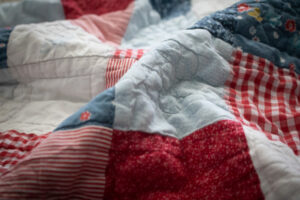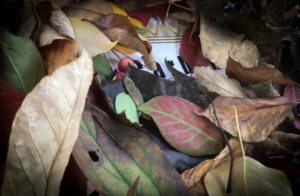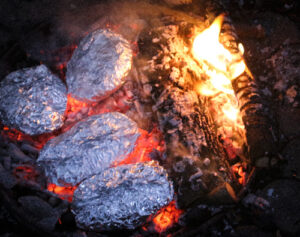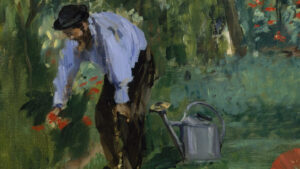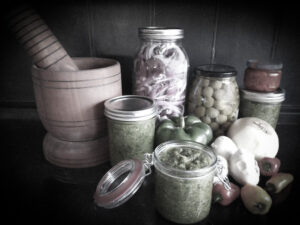How to Grow Sourdough and Friendships

Mrs. April Jaure

It was midnight on New Year’s Eve, and my husband and I raised our glasses in a toast. “To a year of digestive health!” Clink. I said that only half-jokingly. Instead of champagne, our glasses were filled with kombucha, which is why I made that toast, but the truth was that my first of two New Year’s resolutions was to learn how to make sourdough bread. Years prior, I used to bake all my family’s bread, but I had stopped when we avoided eating grains for a few years due to food sensitivities. We had been incorporating grains back into our diet for a few months when 2020 arrived, and I wanted to try my hand at sourdough baking. Sourdough is likely the healthiest way to eat bread as it allows the wild yeasts in the dough to digest much of the gluten in the bread, making it more digestible for us. The fermentation process also neutralizes the phytic acid found in whole grains, making the vitamins and minerals within it bioavailable. Of course, in pre-pandemic January I didn’t know just how important a skill that would turn out to be. I just wanted to eat bread.
My second resolution was to invest more time in intentionally building friendships. I have the tendency to throw myself into projects and focus so much on accomplishing everything on my to-do list I don’t always make relationship-building the priority it should have in my life. But, at least in theory, I believe that the quality of life is measured by having a number of close relationships. As Euripides, the Greek playwright, famously said, “The greatest pleasure in life is love.” I hope he was including filial love in that.
When I made these goals, I thought they were two unrelated ambitions. As it turns out, in addition to providing better nutrition for my family, learning to grow my own sourdough starter from scratch helped me grow a friendship as well.
Like the very first sourdough in ancient Egypt, the nurtured friendship happened by accident. An acquaintance offered to share some local honey with me. Her father is a seventh-generation beekeeper, and he loves to share with others. I gladly accepted. Then one day, as I was preheating my oven in preparation for baking two loaves of sourdough bread, the thought occurred to me to share a loaf with her family, which I did. After that, a sort of informal barter developed. When my honey jars are empty, I bake some sourdough bread or buns. I deliver the empty jars to her house, along with the bread. My friend brews a pot of fresh coffee, and we sit in her sunny dining room or on her porch, and we chat for a while. A few days later, once she has had the chance to fill the honey jars, she delivers them to my house, wherein I provide our afternoon coffee, and we sit on my slip-covered couch and we chat for another hour or two. In doing this, the person who was an acquaintance has become a good friend.
If you would like to make your own sourdough starter from scratch, it takes a couple of weeks to grow, but it is easy to do. I hope the recipe below will help you check off one of your New Year’s health resolutions, or better yet, deepen a friendship.
— April
What You Need

Ingredients:
• Water
• Rye flour
• Bread flour
Materials:
• Kitchen scale. (Measuring by weight instead of volume will greatly improve your results. You can purchase a small digital kitchen scale for about $20; it need not be big or fancy.)
• Pint-sized mason jar with lid
• Quart-sized mason jar with lid
• Wooden spoon
What You Do



1. To grow your own starter, begin with a clean, pint-sized mason jar.
2. Put 50 grams (1.8 ounces) of water in the jar, 20 grams (0.7 ounces) of rye flour, and 30 grams (1.1 ounce) of bread flour, and stir with the wooden spoon. The extra protein in rye and bread flour will help the starter grow faster.
3. Put on the lid and let it sit on your kitchen counter for twelve hours.
4. After twelve hours, you’ll need to remove all the jar’s contents except 10 grams (0.4 ounces) of it. What you remove is called the “discard.” Don’t worry, though — this doesn’t actually get thrown out. Put the discard in a quart-sized jar in your refrigerator. I like the wide-mouthed jars the best. Whenever you wish to use up the discard, it can be used in biscuits, scones, pancakes, and crepes, so none of it goes to waste.
After the discard has been removed from your starter, repeat steps 2 – 4.
If you discard and feed your sourdough every morning and evening, you will grow a starter that you can bake within about two to three weeks. Every morning and evening, discard down to about 10 grams, then feed the starter. That’s it. Your starter will begin to create bubbles that you can see, and it will emit a pleasant aroma that you can smell when you open the jar.
Once a week, I transfer my starter to a clean jar. If I’ve run out of rye or bread flour, I’ve substituted all-purpose flour or just omitted the rye, and that is okay, but the starter does seem to prefer the added protein that rye and bread flour provide. It is a little thicker and more bubbly, whereas without these I’ve noticed it gets a little runny.
Once the sourdough starter is ready to bake with, you can use some of it to make great sourdough creations. Be sure to save some as your starter, so you don’t have to grow it all over again from scratch. Once the sourdough is happy and healthy, if you bake every day, you can feed it once a day. If you bake once a week, you can put it in the refrigerator for a few days, but take it out again a couple of days prior to the bake in order to let it perk up and get a couple of feedings in before you use it.
If you neglect your starter for more than a few weeks, you will likely have to start over. If there is any mold, or orange or pink streaks, best to throw it out and try again. Sourdough starter is pretty forgiving, but has its limits.
So that is how to build a sourdough starter from scratch. Pretty easy, don’t you think? If you would like to build a friendship, my recipe for that is even simpler:
1. Grow your own sourdough starter (see above)
2. Bake something with it.
3. Share some of your baked goods with someone you’d like to know better. Just as with sourdough starter, the more regularly you feed it, the faster a friendship will grow.







